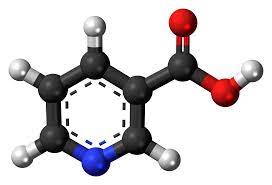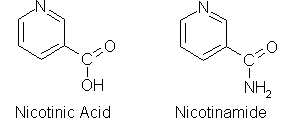Vitamin B3: Niacin - the Vitamin You Really Feel!
Vitamin B3 - also known as niacin - is one of the few vitamins we can take that often causes an immediate, dramatic effect that we can both feel and see. That effect is called flushing, and a niacin flush is exhilarating to some people, disturbing, and annoying to others, but it definitely can't be ignored.
A niacin flush can vary from a slight pink color and tingling of the skin on the face and arms - not unlike blushing - to a dramatic reddening that looks and feels like sunburn, along with a sensation of heat.
 This flush is caused by dilating your blood vessels, especially your capillaries. When you get a niacin flush, it's a harmless reaction that shows that your body is saturated with this essential nutrient.
This flush is caused by dilating your blood vessels, especially your capillaries. When you get a niacin flush, it's a harmless reaction that shows that your body is saturated with this essential nutrient.
A niacin flush usually lasts fifteen minutes to half an hour, and afterward, you'll often feel more relaxed, with an enhanced sense of well-being.
Some doctors recommend that you take niacin right up to the point of slight flushing, indicating that you've taken just enough. The human body gradually adapts to Vitamin B3 supplementation, too, so what causes a flush today might not cause one next month.
One of niacin's remarkable properties is that it can help you relax without the need for artificial substances like "sleeping aids" and help you fall asleep more rapidly at night. Dr. Andrew Saul says, "Niacin can have a sedating, calming effect at huge doses. This is more amazing as it is a nutrient."
Saul uses Vitamin B3 not only to help in relaxing but to improve the mental functioning of people suffering from schizophrenia, dementia, and depression. (He also recommends supplementing at least an equivalent amount of Vitamin C simultaneously to moderate B3's effects on the GI tract and other changes.)
Dr. Jacob Teitelbaum calls niacin "a natural tranquilizer". He cites a study on rats in which "niacin had similar effects to valium on the turnover of serotonin, noradrenaline, dopamine, and GABA in the brain that is thought to be affected by anxiety without being addictive. Some experts go so far as to call niacin 'Nature's Valium.'"
Vitamin B3 is also one of the best - and most natural - treatments known for elevating the "good cholesterol" [high-density lipoprotein (HDL)] levels in your bloodstream and diminishing the lousy cholesterol [low-density lipoprotein (LDL)].
Patients taking 3,000 mg of Vitamin B3 daily (starting day one with 1,000 mg, day two with 2,000 mg, and 3,000 mg per day after that) were found to have up to a 25 percent lower level of bad cholesterol and a 50 percent reduction in triglyceride levels. These factors also lead to lower heart disease mortality among those taking niacin supplements.
have up to a 25 percent lower level of bad cholesterol and a 50 percent reduction in triglyceride levels. These factors also lead to lower heart disease mortality among those taking niacin supplements.
Dr. John A. Rumberger of the Princeton Longevity Center states that niacin may not help if a patient already has minimized his lousy cholesterol levels through "proper diet, attaining a proper weight and body composition, regular aerobic and resistance training" and treatment with statins (cholesterol-reducing prescription drugs).
But if that goal has not yet been achieved, supplementing with Vitamin B3 is "quite clinically appropriate." According to Dr. Andrew Saul, niacin can also reduce the severity of anxiety and depression.
Dr. David Williams recommends that patients with arthritis take between 1,000 to 4,000 mg of niacinamide daily (in the form of niacinamide) in five or six doses throughout the day to relieve pain and stiffness in their joints. In action very similar to a niacin flush, Niacin in this form opens up the blood vessels deep in the joints, giving significant relief.
Studies have shown that niacin helps reduce atherosclerosis - the hardening of the arteries - a major cause of cardiovascular disease, one of the civilized world's major killers. According to some recent research, taking Vitamin B3 supplements makes a second heart attack less likely if you've already had a heart attack.
Research is ongoing to follow up on initial clues that niacin also lowers the risk of contracting Alzheimer's disease, cataracts, osteoarthritis, and type 1 diabetes. Dr. David Williams says that if any prescription drug had all the benefits of "dirt cheap" niacin, "the media would be singing its praises."
According to Dr. Abram Hoffer, who practices the regular use of niacin in treating depression and schizophrenia, 1,000 mg of niacin taken three times daily improves memory and can reverse senility in some patients. It also, as already stated, gives a relaxing and calming effect without the necessity of using expensive, artificial drugs.
Niacin was first described by a chemist named Hugo Weidel in 1873. Weidel was studying the properties of nicotine, and when oxidizing nicotine using  nitric acid, he discovered what we now call niacin or Vitamin B3.
nitric acid, he discovered what we now call niacin or Vitamin B3.
Initially called nicotinic acid, but when its disease-curing and other biological properties became known, it was decided to change the name to prevent the public from getting the misapprehension that cigarettes are good for you (they're not!) or contain vitamins. So "niacin" was coined, combining select letters from the words "nicotinic acid vitamin."
Niacin is one of the water-soluble vitamins, meaning that 1) it's needed for life to continue; 2) the body can't produce its supply, and 3) any B3 beyond what the body can use right now is not stored and is instead almost immediately flushed out in the urine. Therefore, we all need both an adequate and a steady source of niacin.
Niacin deficiency is known as pellagra, and Vitamin B3 was once known as Vitamin P-P for "pellagra preventative." Pellagra's symptoms and effects include what doctors sometimes call the "four Ds": dermatitis, diarrhea, dementia, and death.
More specifically, in addition to the above, pellagra can cause extreme sensitivity to sunlight, skin lesions, hair loss, aggression, quarrelsomeness, swelling, inflammation of the tongue, insomnia, muscle weakness, confusion, lack of coordination, enlarged and weakened heart, paralysis, and nerve damage.
Pellagra is common in Africa and parts of Asia where diets are often poor - but it's also found among the poor and homeless in advanced nations. Alcoholism, and drug interactions that inhibit the absorption of Vitamin B3, can also lead to the disease.
Before its causes were understood, pellagra was a major killer in the American South - estimated that over 100,000 died of it there between 1906 and 1940. When untreated, chronic niacin deficiency can kill you in under five years. But there's a simple cure: treatment with niacin or a niacin-containing compound.
Currently, the Recommended Daily Allowance (RDA) for niacin is 17 to 35 mg daily - notably higher than for some other B complex vitamins. Nevertheless, some physicians say that this is far too low to get maximum benefits from this nutrient and point out that 3,000 to 9,000 mg daily have been used for treating certain conditions, with no known harm or side effects (outside of flushing).
When using such high doses, though, they recommend being under the care of a physician and accommodating the body to the vitamin by starting out with a low dose and gradually increasing it over time. Since niacin can interact with other medications, it's best to consult your doctor when going outside the boundaries set by the RDA.
What are the possible adverse effects of taking Vitamin B3? Well, niacin sometimes irritates the stomach lining if you take it on an empty stomach - so always take it during or immediately after a meal. If you suffer from gout, you should know that niacin can cause you to excrete less uric acid than usual, so avoid taking high-dose niacin if you have gout - though doses in the RDA range and small multiples thereof are probably okay: ask your doctor.
The worst side effect reported with niacin use is liver damage. That side effect was only associated with the timed-release form of niacin, developed to help those who wanted to eliminate the "niacin flush." Avoid the timed-release type of Vitamin B3 (and regulate your daily input carefully if the harmless flushing bothers you), and this won't be a problem.
It takes a tremendous amount of this very safe vitamin to achieve a toxic dose. A toxic dose in dogs is 5,000 mg per 2.2 pounds of body weight. (This would translate to 250,000 mg for a 110-pound human, assuming the toxicity factors remain the same for the two species.)
But we don't know what the toxic Vitamin B3 dose for humans is, for the simple reason that no one, to scientific knowledge, has ever died from taking it. If you experience nausea - an infrequent symptom - after taking niacin, that's a definite sign that you've taken too much. (Ironically, nausea is also a symptom of niacin deficiency!)
Vitamin B3 is one of the "B complex" vitamins and, like the others, is a nutrient necessary for human life and health. It plays an integral part in the body's conversion of carbohydrates (food) into fuel (glucose) for cellular energy and activity.
When considering niacin (Vitamin B3) supplementation, it's often wise to take it as part of a B complex supplement (or multivitamin which contains a blend of the B complex vitamins), because too much of just one of the B vitamins can sometimes cause an imbalance. It's believed that these essential nutrients act in synergy, in which the total input has a more significant beneficial effect than just the sum of its parts.
Similarly, whether you use supplements or not, it's good to include natural, unprocessed foods rich in Vitamin B3 in your diet, as there are trace elements  in these foods that many believe also have a synergistic effect on niacin. Foods rich in niacin include eggs and other animal products, avocados, asparagus, sweet potatoes, carrots, dates, tomatoes, leafy vegetables, broccoli, nuts, whole grains, legumes, and brewer's yeast.
in these foods that many believe also have a synergistic effect on niacin. Foods rich in niacin include eggs and other animal products, avocados, asparagus, sweet potatoes, carrots, dates, tomatoes, leafy vegetables, broccoli, nuts, whole grains, legumes, and brewer's yeast.
And, as I quoted Dr. Williams saying above, niacin supplements are "dirt cheap," and niacin's benefits are equivalent to what we'd imagine those of a "miracle drug" to be.
But niacin is a simple vitamin. It is not patented or patentable, and one can easily find it at your local drugstore, pharmacy, or online from many reputable sellers at meager prices. Checking just eBay alone, I found a bottle of 100 tablets (of 250mg each - a pretty high dose!) of Vitamin B3 for as little as five dollars.
There may be some things we don't like about the modern age. Still, one thing for sure is excellent: We've never had better information about health more easily and widely available, allowing us to take charge of our health through exercise programs, nutrition, and health supplements in a better-informed way than ever before.
Take advantage of this situation, and begin achieving better health and life today!
REFERENCES
Mayo Clinic Online, "High Cholesterol," http://www.mayoclinic.org/diseases-conditions/high-blood-cholesterol/in-depth/niacin/art-20046208?pg=2 , accessed 18 May 2014
Dr. David Williams, "The Many Benefits of Niacin," http://www.drdavidwilliams.com/niacin-benefits/ , accessed 18 May 2014
Rumberger, John, Princeton Longevity News, "The 'new' controversy about Niacin to treat heart disease," http://princetonlongevitynews.com/2011/07/27/the-%E2%80%98new%E2%80%99-controversy-about-niacin-to-treat-heart-disease/ , accessed 19 May 2014
Saul, Andrew W., Doctor Yourself, "How to Determine a Saturation Level of Niacin," http://www.doctoryourself.com/niacin.html , accessed 18 May 2014
Smart Publications, "Overcome Anxiety While Staying Calm and Energized Naturally," http://www.smart-publications.com/articles/overcome-anxiety-while-staying-calm-and-energized-naturally , accessed 18 May 2014
Haas, E.M., "Vitamin B3Niacin," Excerpt from Staying Healthy with Nutrition: The Complete Guide to Diet and Nutritional Medicine
"Guidelines for Niacin Therapy For the Treatment of Elevated Lipoprotein a (Lpa)," Rush Hemophilia & Thrombophilia Center, August 15, 2002
Katzung, Bertram G. (2006), Basic and Clinical Pharmacology, New York: McGraw-Hill Medical Publishing Division. ISBN 0-07-145153-6
Barter, P. (2006). "Options for therapeutic intervention: How effective are the different agents?", European Heart Journal, Supplements 8 (F): F47-F53
WebMD, Vitamins, and Supplements Lifestyle Guide, "Niacin: Vitamin B3," http://www.webmd.com/vitamins-and-supplements/lifestyle-guide-11/supplement-guide-niacin?page=1 , accessed 18 May 2014
Saul, Andrew, Doctor Yourself Online, "Psychosis, Schizophrenia, and Nutritional Therapy," http://www.doctoryourself.com/psychiatry.html , accessed 18 May 2014
- Vitamin D The Sunlight Vitamin [Last Updated On: August 24th, 2023] [Originally Added On: September 10th, 2020]
Word Count: 1981







